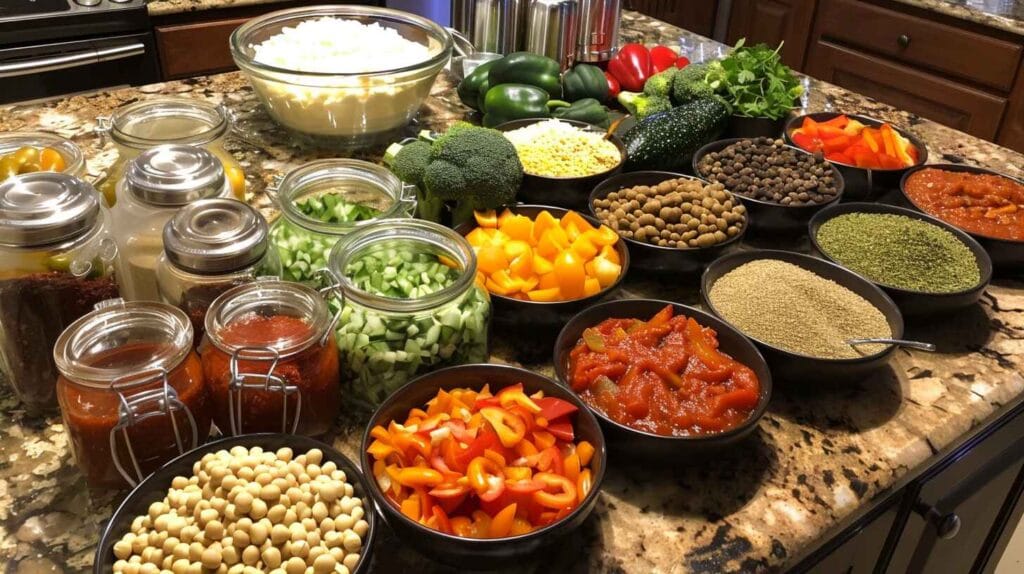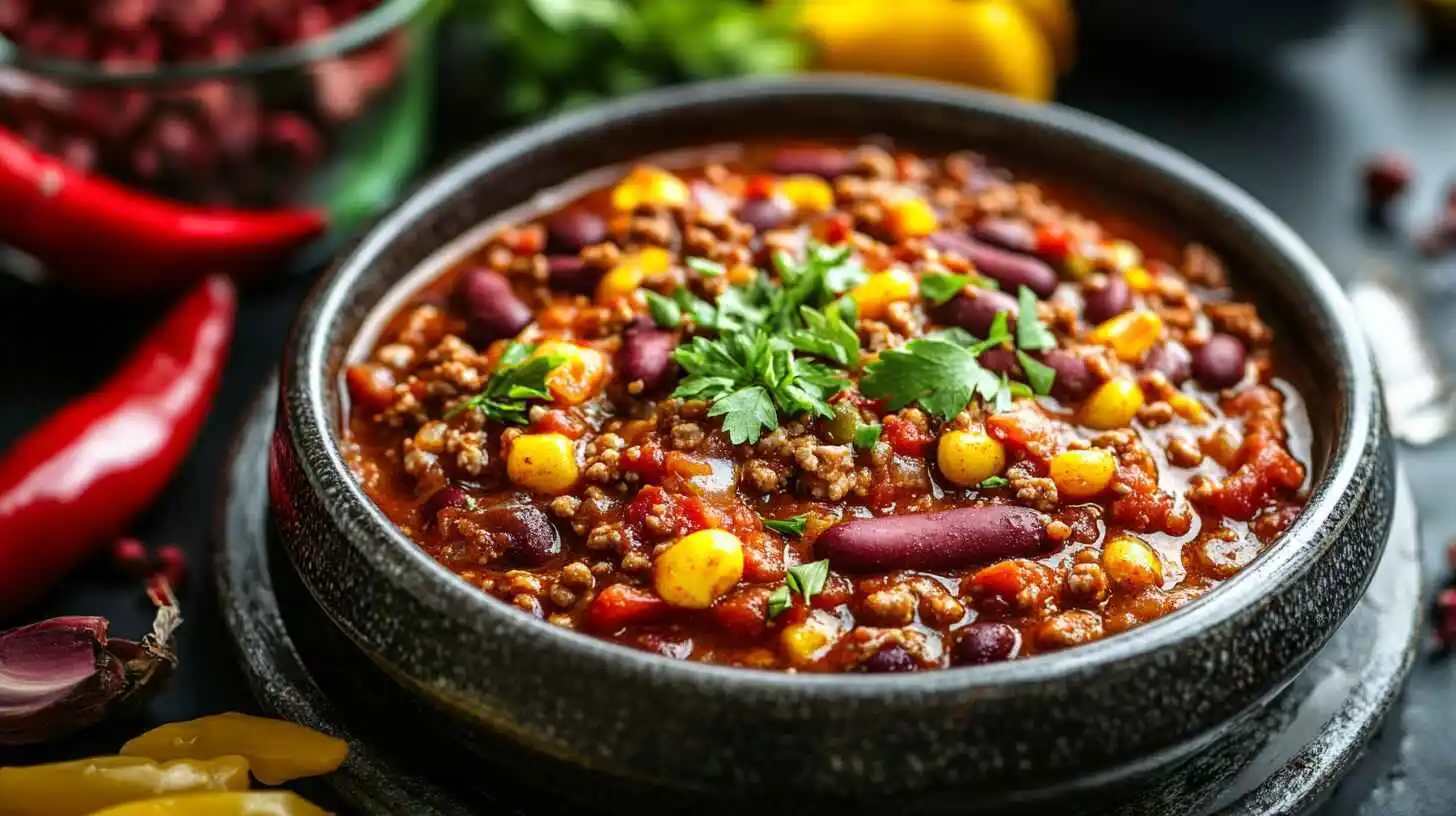Table of Contents
Can I Eat Chili on a Low Sodium Diet? If you’re a chili lover and trying to follow a low sodium diet, you might wonder – can you still If you’re a chili lover trying to follow a low-sodium diet, you might wonder – can you still enjoy a steaming bowl of this comfort food without exceeding your sodium limit? Chili, known for its rich flavors and hearty ingredients, often contains high sodium levels, especially when using canned products or premade spice mixes. But the good news is that you can enjoy chili on a low-sodium diet with the proper adjustments!
This article will walk you through everything you need to know, from understanding sodium intake to crafting a delicious, heart-friendly bowl of chili that won’t compromise flavor.
Understanding Low Sodium Diets
Can I eat chili on a low-sodium diet?
This is a common question for those looking to manage their sodium intake while enjoying flavorful dishes. A low-sodium diet focuses on reducing the amount of salt in your meals to help lower blood pressure and reduce the risk of heart disease. Have you ever wondered, “Can I eat chili on a low-sodium diet?” If you make the proper adjustments, the answer is yes. By selecting fresh ingredients and avoiding processed foods, you can enjoy hearty and healthy chili.
So, can you eat chili on a low-sodium diet, even using canned beans and tomatoes? Absolutely! Opt for no-salt-added varieties or rinse regular canned goods to lower sodium. If you’ve been curious and asking yourself, “Can I eat chili on a low-sodium diet without losing flavor?” The key is to concentrate on herbs and spices to develop depth.
Can you eat chili on a low-sodium diet while still feeling satisfied? Yes! Chili can be filled with lean meats, beans, and vegetables, making it nutrient-dense and full of fiber. Ultimately, if you’re looking for answers to, “Can I eat chili on a low-sodium diet and still enjoy the taste?” the solution lies in how you prepare and season your ingredients.
Benefits of Reducing Sodium Intake
Lowering sodium levels in your diet has a host of health benefits. It can:
- Lower blood pressure – Reducing sodium helps ease the pressure on arteries.
- Decrease risk of heart disease and stroke – A heart-healthy diet with minimal sodium promotes better cardiovascular health.
- Improve kidney function – Excess sodium can lead to kidney stress, while low sodium diets support kidney performance.
- Reduce fluid retention and bloating – Sodium causes water retention; cutting back helps prevent puffiness and swelling.
A low-sodium diet doesn’t mean you have to compromise on flavor. With a few smart swaps and fresh ingredients, even savory dishes like chili can fit into your meal plan.
Chili and Its Typical Sodium Content

Common Ingredients in Chili
Traditional chili recipes include ground beef, canned tomatoes, beans, and pre-packaged chili seasoning. While these ingredients provide bold flavor and hearty texture, they are common culprits for sneaky sodium. Here are typical sodium levels for key chili components:
- Canned beans – Around 400-500 mg per serving.
- Canned tomatoes – Often 300-400 mg per cup.
- Broth – Regular chicken or beef broth can contain up to 900 mg per cup.
- Packaged chili seasoning – Approximately 300-600 mg per tablespoon.
- Processed meats (sausages or chorizo) – Can exceed 800 mg per serving.
Combining all these ingredients, a single serving of chili could easily surpass 1,000 mg of sodium – half or more of the daily limit for someone on a low-sodium diet.
How Much Sodium is in Traditional Chili?
A bowl of standard chili from a restaurant or store-bought variety may contain 800 to 1,500 mg of sodium. Even homemade versions can be high in sodium if you use canned ingredients or table salt liberally. However, you can drastically cut the sodium with some creativity while preserving chili’s signature rich, spicy flavor.
Can You Eat Chili on a Low Sodium Diet?
Is Chili Adaptable to Low Sodium Requirements?
Yes, chili can be easily adapted to fit a low-sodium diet without sacrificing the flavor and heartiness that makes it so satisfying. The key lies in controlling the ingredients and making smart substitutions. By using fresh or no-salt-added products, eliminating processed components, and relying on spices and herbs, you can recreate the bold flavors of chili while significantly cutting down on sodium.
Chili is a flexible dish, allowing for experimentation with vegetables, lean proteins, and plant-based options. This versatility makes it a perfect candidate for a low-sodium makeover.
Modifying Recipes for Low-Sodium
Reducing sodium in chili involves more than just cutting out salt. Here are some practical ways to keep chili tasty but sodium-friendly:
- Skip the canned goods or use low-sodium versions – Opt for fresh tomatoes or no-salt-added canned varieties. Rinse the beans thoroughly to eliminate any sodium that is left.
- Make your seasoning – Store-bought chili seasoning is packed with salt. Mix your own blend using cumin and paprika, garlic powder, and various other spices to lower sodium.
- Use low sodium broth or water – Regular broths contain excessive sodium. Choose low sodium or make homemade vegetable or chicken broth.
- Focus on vegetables – Bulk the chili with more peppers, onions, zucchini, and carrots. Vegetables add natural flavor without extra sodium.
- Experiment with lean proteins – Use lean cuts of chicken, turkey, or even tofu instead of processed meats high in sodium.
Chili’s boldness doesn’t come from salt alone – the combination of spices, fresh ingredients, and slow simmering creates its comforting taste.
Low Sodium Ingredients for Chili
Fresh Ingredients vs. Canned
Whenever possible, opt for fresh ingredients over canned or packaged items. Fresh tomatoes, bell peppers, onions, and garlic provide robust flavor and nutrients without hidden sodium. If canned products are necessary, choose the no-salt-added or low-sodium versions and rinse thoroughly to reduce sodium content by up to 40%.
Low Sodium Alternatives for Key Ingredients
Here are some easy swaps to keep chili low sodium but still delicious:
- Tomatoes – Fresh diced tomatoes or low-sodium canned options.
- Beans – Dried beans cooked at home with no added salt.
- Broth – Use homemade broth or no-sodium stock.
- Meat – Lean ground turkey, chicken, or tofu instead of sausage or processed meats.
- Cheese – If adding cheese, choose low-sodium varieties or omit them entirely.
Herbs and Spices for Flavor Without Salt
Spices are the backbone of chili. Use generous amounts of:
- Cumin – Earthy and warm, perfect for chili.
- Smoked paprika – Adds depth and a hint of smokiness.
- Garlic and onion powder – Intense flavor without the salt.
- Chili powder – Essential for heat and complexity.
- Fresh herbs – Cilantro, oregano, and parsley add brightness.
Low Sodium Chili Recipes
Simple Low Sodium Chili Recipe
Here’s a quick and easy low-sodium chili that’s packed with flavor but light on salt:
Ingredients:
- 1 lb lean ground turkey or chicken
- 1 large onion, diced
- 3 cloves garlic, minced
- 1 bell pepper, diced
- 2 large tomatoes, diced (or one can of no-salt-added tomatoes)
- 1 cup no-salt-added black beans (rinsed if canned)
- 1 cup kidney beans (no-salt-added)
- 1 ½ cups low-sodium vegetable or chicken broth
- 1 tbsp olive oil
- 2 tsp cumin
- 2 tsp chili powder
- 1 tsp smoked paprika
- ½ tsp black pepper
- ½ tsp garlic powder
- ½ tsp onion powder
- Fresh cilantro (optional for garnish)
Instructions:
- The olive oil is heated in a large saucepan over moderate flame. Add chopped garlic and onions, sautéing until the onions soften.
- Add ground turkey or chicken, breaking it apart as it cooks until it is no longer pink.
- Stir in diced bell pepper, tomatoes, and beans.
- Pour in the low-sodium broth and mix well.
- Add all spices – cumin, chili powder, paprika, garlic powder, and black pepper. Stir to combine.
- The chili should be brought to a simmer, then reduce the heat to the simmer. Let it cook uncovered for 30-45 minutes, stirring occasionally.
- Taste and adjust spices if needed. Garnish with fresh cilantro and enjoy!
Vegetarian Low Sodium Chili
This plant-based chili is hearty and perfect for meatless meals.
Ingredients:
- 1 tbsp olive oil
- 1 large zucchini, diced
- 1 bell pepper, diced
- 1 carrot, shredded
- 2 cloves garlic, minced
- 1 onion, chopped
- 1 cup corn (fresh or frozen)
- 1 cup no-salt-added pinto beans
- 1 cup no-salt-added black beans
- 2 large tomatoes, diced
- 1 ½ cups low-sodium vegetable broth
- 2 tsp cumin
- 1 tsp chili powder
- 1 tsp smoked paprika
- ½ tsp black pepper
Instructions:
- In a large saucepan, cook olive oil at moderate temperatures. Add garlic and onion, and sauté until soft.
- Toss in zucchini, bell pepper, and carrot. Cook for 5-7 minutes until softened.
- Stir in tomatoes, corn, and beans. Mix well.
- Pour in vegetable broth and season with cumin, chili powder, paprika, and black pepper.
- Simmer for 30 minutes, stirring occasionally.
- Serve hot with a sprinkle of fresh parsley or cilantro.
Chicken or Turkey Chili (Lean Protein Option)
Chicken or turkey can be the dish’s star for a leaner option.
Ingredients:
- 1 lb ground chicken or turkey
- 1 onion, diced
- 1 bell pepper, chopped
- 3 cloves garlic, minced
- 2 cups no-salt-added diced tomatoes
- 1 cup low-sodium chicken broth
- 1 cup no-salt-added white beans
- 1 tbsp olive oil
- 2 tsp cumin
- 1 tsp oregano
- 1 tsp smoked paprika
- ½ tsp garlic powder
Instructions:
- In an enormous pot. Sauté garlic and onions.
- Add turkey or ground chicken and cook until it is cooked.
- Toss in bell pepper, tomatoes, and beans.
- Pour broth and season with cumin, oregano, paprika, and garlic powder.
- Simmer for 40 minutes, stirring occasionally.
Tips to Reduce Sodium in Chili
Cooking Methods to Enhance Flavor Naturally
To make chili flavorful without relying on salt, focus on techniques that develop depth and complexity:
- Roast Vegetables – Roasting tomatoes, peppers, and garlic before adding them to chili intensifies their natural sweetness and umami.
- Caramelize Onions – Simmering onions until golden brown adds a rich, savory flavor base.
- Simmer Longer – Allowing chili to simmer for an extended period helps the flavors meld and deepen naturally.
- Layer Spices – Add spices in stages during cooking, allowing them to bloom and release their oils, enhancing the dish’s overall taste.
- Acid for Balance – A splash of lime juice or apple cider vinegar at the end brightens the flavors without sodium.
Reducing Sodium in Canned Products
If you’re using canned beans, tomatoes, or broth, follow these tips to cut down on sodium:
- Rinse Canned Beans Thoroughly – Rinsing can reduce sodium by up to 40%.
- Choose No-Salt-Added Varieties – Opt for canned products labeled “no-salt-added” or “low sodium.”
- Dilute Broth with Water – If you can’t find low-sodium broth, mix regular broth with water to cut the sodium content in half.
Adding Bulk with Beans and Vegetables
Beans, vegetables, and grains like quinoa or barley add volume to chili without increasing sodium. Consider the following:
- Beans – Black, pinto, and kidney beans are excellent fillers.
- Sweet Potatoes – Adds natural sweetness and pairs well with spicy flavors.
- Zucchini and Carrots – Boosts fiber and nutrients while keeping the dish hearty.
Reading Labels and Choosing Ingredients
Understanding Sodium Content on Labels
When grocery shopping for chili ingredients, pay close attention to labels:
- Look at “Low Sodium” – Products identified as “low sodium” contain less than 140 mg sodium for each portion.
- Watch for Hidden Sodium – Ingredients like soy sauce, ketchup, and bouillon can be high in sodium, even if they don’t taste salty.
- Check Serving Sizes – Sodium content is often listed per serving, not container. A can of tomatoes might seem low in sodium, but the entire can could contain triple the amount listed.
Choosing the Right Canned Tomatoes and Beans
- Tomatoes – Look for “no-salt-added” or buy fresh and dice yourself.
- Beans – Purchase dried beans and cook them at home for a virtually sodium-free option.
- Broth – Make homemade broth using leftover vegetable scraps or bones without salt.
Benefits of Eating Low Sodium Chili

Health Benefits
Switching to low-sodium chili offers a range of health benefits that go beyond just reducing your salt intake. Here’s how this simple dietary shift can positively impact your overall well-being:
- Lower Blood Pressure – By cutting down on sodium, your body retains less water, which helps reduce the strain on arteries and lowers blood pressure.
- Heart Health – Reducing sodium decreases the risk of cardiovascular diseases, including heart attacks and strokes.
- Kidney Protection – Excess sodium can overwork the kidneys. A low-sodium diet helps maintain kidney function and reduces the risk of kidney stones.
- Weight Management – Low-sodium diets encourage the consumption of whole, unprocessed foods, which can help with weight control.
- Less Bloating – Reducing sodium minimizes water retention, resulting in less bloating and puffiness.
Weight Management and Nutrient Boost
Low-sodium chili is typically packed with fiber-rich beans, lean proteins, and vegetables. These nutrient-dense ingredients keep you fuller for longer, making managing portion sizes easier and avoiding unhealthy snacks. Fiber supports digestion and promotes satiety, helping with weight control in a natural, healthy way.
Reduced Risk of Heart Disease
Regularly consuming low-sodium meals lowers the risk of heart-related illnesses. Chili made with fresh vegetables, lean meats, and homemade broth is heart-healthy and packed with antioxidants, which combat inflammation and promote cardiovascular health.
Common Mistakes to Avoid
Using High Sodium Broth
One of the most common mistakes when making chili is using regular broth, which can add hundreds of milligrams of sodium per cup. Always opt for low-sodium or no-salt-added broth. Alternatively, make your own by simmering vegetables, herbs, and bones at home.
Over-Relying on Processed Meats
Chorizo, sausage, and pre-cooked meats are often packed with salt and preservatives. Instead, choose lean cuts of meat like ground turkey, chicken, or beef, and season them yourself using fresh herbs and spices.
Neglecting to Check Labels
It’s easy to assume that chili ingredients are low in sodium, but products like canned beans, tomatoes, and seasoning blends can be deceptively high. Always read labels carefully and select no-salt-added versions whenever possible.
Forgetting to Rinse Canned Goods
If you must use canned beans or vegetables, always rinse them thoroughly. This simple step can remove up to 40% of the sodium, significantly lowering the overall sodium content of your chili.
Frequently Asked Questions (FAQ):
1. Can I add cheese to my low-sodium chili?
Yes, but choose low-sodium cheese or use smaller amounts. Sharp cheeses like aged cheddar pack more flavor, allowing you to use less. Alternatively, nutritional yeast can provide a cheesy flavor without added sodium. This versatile ingredient is an excellent substitute in many recipes, offering a savory, umami-rich taste without increasing sodium intake.
2. How do I make chili flavorful without salt?
Focus on layering spices like cumin, smoked paprika, chili powder, garlic powder, and oregano. Fresh herbs and a splash of lime juice or apple cider vinegar can brighten the dish and enhance flavors without relying on salt. For inspiration, check out this low-sodium chili recipe demonstrating how to achieve bold flavors naturally.
3. What is the daily sodium limit on a low-sodium diet?
Most low-sodium diets limit The daily sodium intake to 1,500 to 2,000 mg. This is significantly lower than the average intake of around 3,400 mg for most people. If you’re unsure how to reduce sodium in meals, explore how to reduce sodium in canned chili for practical tips.
4. Can I use canned beans for low-sodium chili?
But opt for no-salt-added canned beans or thoroughly rinse regular canned beans. Rinsing can lower sodium levels by as much as 40 percent. Dried beans, cooked at home, are naturally low in sodium and an excellent option. Need a guide on making low-sodium chili with beans? Here’s a recipe to get started.
5. Is store-bought chili seasoning high in sodium?
Typically, yes. Store-bought chili seasoning blends can contain up to 500-600 mg of sodium per tablespoon. Instead, blend using cumin, chili powder, paprika, and other herbs for full flavor without the sodium. Making your baking powder helps control sodium in different recipes, as commercial baking powders often contain added salt.
6. How can I thicken chili without adding sodium?
To thicken chili, let it simmer uncovered to reduce the liquid naturally. You can also mash some beans or add puréed vegetables like carrots or sweet potatoes to thicken the consistency without increasing sodium. For more tips, see how a potato can reduce salt in chili and contribute to a thicker, heartier dish.
Conclusion
Eating chili on a low-sodium diet is entirely possible – and delicious – with a few thoughtful adjustments. By swapping high-sodium ingredients for fresh, low-sodium alternatives and embracing herbs and spices, you can create a hearty, flavorful bowl of chili that aligns with your health goals. Low-sodium chili protects your heart, lowers blood pressure, and provides a nutrient-dense meal full of fiber and lean protein.
Whether you prefer a vegetarian version or a lean turkey chili, the versatility of this dish means there’s something for everyone. Enjoy the comfort and warmth of chili without worrying about your sodium intake!
